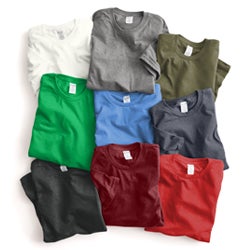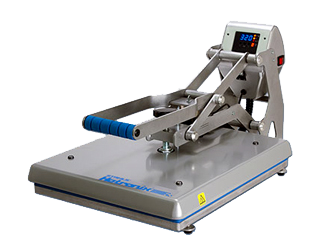Screen Printed Transfers vs Screen Printing: What's The Difference?
Browse Video Categories
Transfer Application | Artwork & Apparel | Easy View Tutorials | Webinars | Ordering Tips | Business | Heat Presses
Hey Friends, Dave here with Transfer Express, and today, we’re talking all about the most popular way to put a graphic on a t-shirt: screen printing! Of course, if you know us here at Transfer Express, screen printing is kind of what we do. Our Goof Proof® screen printed transfers have been the number one choice for plastisol ink transfers for home-based businesses, and even some of the biggest brands you can name. But we get asked all the time, ‘what's the difference between screen printing and screen-printed transfers?’
So today we’re covering it all. We’ll be comparing some hand pulled screen prints here, to our Goof Proof screen printed transfers, and then we’re even going to compare our prints here in studio to some t-shirts we ordered printed on an automatic press from a local print shop here. Ready? Let’s get to printing!
To kick us off, we’re going to do some screen printing ourselves. Now, this is how my journey into the apparel decorating world started well over a decade ago on my kitchen table, with a nice hefty learning curve to boot. Not only are you going to have to learn sizing and placement, but there’s quite a bit of a learning curve, everything from the supplies you’ll need like, screens and mesh count, emulsions or stencils, squeegees, like this one, inks (water-based or plastisol), curing units, chemicals for cleanup… and then you get into printing specifics, like squeegee angle, pressure, off-contact and on and on - a process for sure.
Here we didn’t use emulsion (but it was the biggest frustration for me getting started back in the day) but instead a method popular these days for small runs by using permanent, cut vinyl for our stencil. We’re also using water-based inks here, because we’re not dealing with the chemicals, we need to clean up plastisol inks, something to take into consideration if you’re just starting a t-shirt business from your home, or if you’re an existing business looking to add apparel printing to your list of services.
So, with screen printing here, you’ll see essentially, we’re pushing ink through our stencil and down onto our t-shirt for our print and we’ll cure it with our heat press for a finished shirt. I do want to mention, to print shirts at volume (or really at any scale) you’ll need a press, something that’ll stay in registration, allow you to make adjustments, and make it easy for loading and unloading shirts- so factor that into the equation.
Now to justify the time it took to get our screen ready and ink it up, and then cleanup with scrubbing the ink out of this screen when we’re done, this isn’t the best method for doing small runs. Typically here you’d be looking at 24 quantity at a minimum with the time you have to invest to it- making it much better for big runs, and all the work is multiplied if you add another color, because then we’re making and reclaiming another screen or screens on top of this one. So, we’re going to keep this one color for the brevity of this video while our other two options are 2-color.
After all the work, these water-based inks here leave us with a decent, soft handprint (after you get the hang of it). We used our heat press to cure our inks, but you can also use conveyor dryers or flash units, but then again, more supplies you’ll need. We’ll take a closer look here at these finished prints again in a little bit.
For our second example here, we sent some artwork over to a local screen print shop. These shirts here were printed in plastisol on automatic presses, and the prints are pretty good quality, but we paid a premium and had our longest turnaround time to have finished shirts in our hand at a turnaround time of two weeks. Now granted, we didn’t lift a finger (or squeegee) screen printing ourselves, but the wholesale cost of pre-printed t-shirts is about double than what it took us to print ourselves. Looking to print it yourself with autos? You’ll have to have deep pockets and a WHOLE bunch of steady work coming in. Not to mention the specialized training to setup and run auto presses. But you’ll need an established business and a stable base of customers before considering that jump- and an employee or two to run them.
There were minimum quantities here, so this also might not be the best option for on-demand fulfillment- outsourcing or auto screen printing is going to be much better suited for bulk runs.
Lastly, let’s print a t-shirt here with our heat press and screen-printed transfers. Our Goof Proof screen printed transfers are easily ordered online, and turnaround times start as little as the next business day, so transfers are in your hands ready to apply to your t-shirts in days, not weeks.
Goof Proof is the same plastisol ink we saw printed on our last example- just printed onto a paper carrier with an adhesive powder added, so you can apply to whatever you want, when you want. With a quick application as low as 4 seconds, it’s just as efficient (if not more) than pulling a squeegee- but for almost any quantity. With minimums as low as 6 and steep quantity breaks, you’re still protecting that profitability.
These Goof Proof screen printed transfers, arrive ready to apply- no need for layering colors or any screens or setup past sending your art file (or designing online). Just position and apply!
Of course, we’ll be printing here with a heat press, the only equipment we need. No dryers, no supplies needed- just electricity. No cleanup, no mess, and a pretty limited learning curve- so much easier to learn yourself, or train someone to do compared to the other methods we’ve talked about here today.
Heading back to the heat press here, all we have to do is load our shirt, prepress to remove moisture and wrinkles and then place our transfer and print! One step application faster than it took us to cure our first screen print we did… complete with a smooth and easy hot peel… all in a small footprint of about 4 square feet.
I will say, had I known about screen printed transfers back then- I don’t know if I would have ever pulled a squeegee- I spent more than the cost of a heat press on inks and emulsion, different squeegees, flash units and a press not to mention hours of frustration before I had a print that I felt comfortable selling- from that first press with Goof Proof on your heat press, you’ve got retail-ready results with a plastisol print.
Now that we’ve had our story time and reviewed all three ways screen print, let’s take a look at these printed t-shirts!
Be sure to subscribe to the Transfer Express YouTube page to stay up to date on all of the helpful t-shirt printing tips, tricks, inspiration and education that we’re dropping every single week. Until next time, I’m Dave, happy pressing!



















